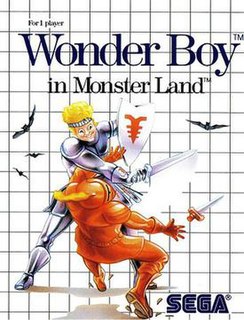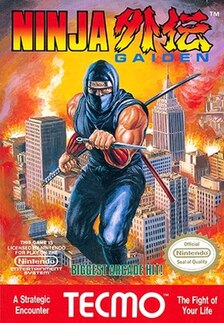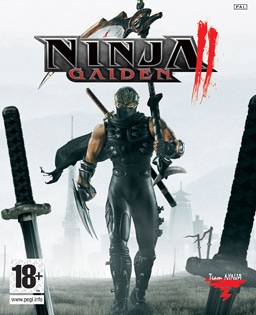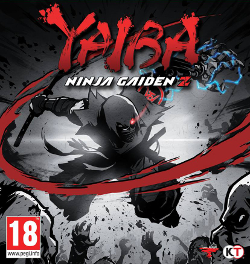
Wonder Boy in Monster Land, known by its original arcade release as Wonder Boy: Monster Land, is an action role-playing platform video game developed by Westone Bit Entertainment and released by Sega in Japanese arcades in 1987 and for the Master System in 1988, with a number of other home computer and console ports following. The game is the sequel to the 1986 game Wonder Boy and takes place eleven years after the events in the previous game. After enjoying over a decade of peace on Wonder Land following the defeat of the evil King by Tom-Tom, later bestowed the title "Wonder Boy", a fire-breathing dragon called the MEKA dragon appeared; he and his minions conquered Wonder Land, turning it into "Monster Land". The people, helpless due to their lack of fighting skill, call for Wonder Boy, now a teenager, to destroy the monsters and defeat the MEKA dragon. Players control Wonder Boy through twelve linear levels as he makes his way through Monster Land to find and defeat the MEKA dragon. Players earn gold by defeating enemies and buy weapons, armor, footwear, magic, and other items to help along the way.
Ninja Gaiden is a series of video games by Tecmo featuring the ninja Ryu Hayabusa as its protagonist. The series was originally known as Ninja Ryukenden in Japan. The word "gaiden" in the North American Ninja Gaiden title means “tale” in Japanese. The original arcade version, first two Nintendo Entertainment System games and Game Boy game were released as Shadow Warriors in PAL regions. As of 2008, the series has shipped over 7.7 million copies.

Ryu Hayabusa is a fictional character who serves as the main protagonist of Tecmo's Ninja Gaiden action-adventure video game series, in addition to featuring as a player character in the Dead or Alive fighting game franchise by Koei Tecmo and Team Ninja where he serves as the protagonist in Dead or Alive 2. He is a dragon-human hybrid who wields an ancestral weapon called the Dragon Sword, and is the leader of the Hayabusa ninja clan. One of Tecmo's most enduring characters, Ryu has appeared on official series merchandise as well as the feature film DOA: Dead or Alive, and has made many crossover appearances in other games. He has received public and critical reception as one of the most iconic ninjas in video games.

Batman Returns is a 1992 beat 'em up video game for various platforms based on the film of the same name. The Sega console versions were published by Sega while the NES and Super NES versions were developed and published by Konami. The MS-DOS and Amiga versions were also published by Konami, but were developed by Spirit of Discovery and Denton Designs respectively. An Atari ST version by Konami was also advertised, but never released. There is also an Atari Lynx version, published by Atari Corporation.

Shining in the Darkness, released as Shining and the Darkness (シャイニング&ザ・ダクネス) in Japan, is a 1991 role-playing video game for the Sega Genesis video game console. It was one of the first role-playing games released for the system, and was the first in the Shining series.
1988 saw many sequels and prequels in video games and several new titles such as Super Contra, Super Mario Bros 2, Assault, Altered Beast, Mega Man 2, Double Dragon II: The Revenge, and Super Mario Bros 3

Ninja Gaiden II: The Dark Sword of Chaos, known in Europe as Shadow Warriors II: The Dark Sword of Chaos, is a side-scrolling platform game developed and published by Tecmo for the Nintendo Entertainment System (NES). This is the second installment in the Ninja Gaiden trilogy for the NES and was released in North America and Japan in 1990, and in Europe in 1992.

Ninja Gaiden III: The Ancient Ship of Doom is a side-scrolling platforming video game developed and published by Tecmo. It was released in Japan on June 26, 1991 for the Famicom and in North America in August 1991 for the Nintendo Entertainment System (NES). The NES version was not released in Europe. It was later ported to the Atari Lynx by Atari and released in 1993 in North America and Europe, the European version retaining the North American Ninja Gaiden III title. It was also re-released as part of its Ninja Gaiden Trilogy Super NES compilation in 1995 in Japan and North America. Long after, it was released for the Virtual Console service in North America on February 18, 2008 for the Wii and in North America and Europe on November 28, 2013 and January 23, 2014 respectively for the Nintendo 3DS. It was designed by Masato Kato, who took over for Hideo Yoshizawa—designer of the first two games in the NES series.

Ninja Gaiden Shadow, released in Japan as Ninja Ryūkenden GB: Matenrō Kessen, in China as Ninja's Skyscraper Fight, and in Europe and Australia as Shadow Warriors, is a side-scrolling action game released for the Game Boy in 1991 by Tecmo. It is a prequel of the NES Ninja Gaiden trilogy.

Ninja Gaiden 3 is an action-adventure hack and slash video game developed by Team Ninja and published by Tecmo Koei. It is the sequel to Ninja Gaiden II and was released worldwide for the PlayStation 3 and the Xbox 360 in March 2012. An updated version titled Ninja Gaiden 3: Razor's Edge was released later that year, originally published by Nintendo for the Wii U.

Taz Mania is the name of several video games based on the Taz-Mania cartoon series. A 2D side-scrolling platform/adventure video game developed by Recreational Brainware and published by Sega on the Sega Mega Drive/Genesis in 1992. Different games were also developed by NuFX and released on the Game Gear and by Technical Wave on the Master System. Other different Taz-Mania games were also published by Sunsoft and released on the SNES and 2 games on the Game Boy were made too. One from David A. Palmer Productions and published by Sunsoft and another from Beam Software and published by THQ.

Ninja Gaiden is an action-adventure game developed by Team Ninja for Xbox, released by Tecmo in 2004. Players control Ryu Hayabusa, a master ninja, in his quest to recover a stolen sword and avenge the slaughter of his clan. It was inspired by Tecmo's Ninja Gaiden series, and is set in the same continuity as Team Ninja's Dead or Alive fighting games.

Ninja Gaiden, released in Japan as Ninja Ryūkenden and as Shadow Warriors in Europe, is a side-scrolling cinematic action-platforming video game. Tecmo developed and published it for the Nintendo Entertainment System (NES); its development and release coincided with the beat 'em up arcade version of the same name. It was released in December 1988 in Japan, in March 1989 in North America, and in August 1991 in Europe. It has been ported to several other platforms, including the PC Engine, the Super NES, and mobile phones.

Ninja Gaiden II is a hack and slash action-adventure video game developed by Team Ninja and published by Microsoft Corporation. It is the sequel to the 2004 title Ninja Gaiden and was released worldwide for the Xbox 360 in June 2008. A reimagined and heavily altered version, titled Ninja Gaiden Sigma 2 was released for the PlayStation 3 later in 2009, and was published by Tecmo Koei, followed by Ninja Gaiden Sigma 2 Plus for the PlayStation Vita in 2013.

Ninja Gaiden: Dragon Sword is a 2008 action-adventure video game released for the Nintendo DS, developed by Team Ninja and published by Tecmo. A main installment in the Ninja Gaiden series, it features the Dragon Ninja, Ryu Hayabusa, as the protagonist. The game is the first portable video game title in the series to be developed by Team Ninja and the first game developed by this company to be released for the Nintendo system. Dragon Sword is set between Ninja Gaiden and Ninja Gaiden II.

Ninja Gaiden (忍者外伝) is an action video game released for the Game Gear in 1991 by Sega with license from Tecmo. It stars Ryu Hayabusa and is part of the Ninja Gaiden series, although it features a plot not connected to any of the other Ninja Gaiden games. The gameplay is similar to previous Ninja Gaiden games where the player jumps between platforms defeating and avoiding enemies.

Ninja Combat is a 1990 side-scrolling beat 'em up video game developed by Alpha Denshi and published by SNK. It was one of the launch titles for both the Neo Geo MVS (arcade) and AES (home) systems.

Batman: The Video Game, is a group of platform games developed by Sunsoft for the Nintendo Entertainment System and Game Boy, loosely based on the 1989 film of the same name. Despite having the same title, each is actually a different game. The NES title is arguably the best known and contains five levels culminating in a showdown with the Joker in the bell tower of Gotham Cathedral. It was received well despite changes from the movie upon which it was based.

Yaiba: Ninja Gaiden Z is a third-person hack and slash video game, and a spin-off of the Ninja Gaiden franchise. It was published by Tecmo Koei and developed by Spark Unlimited. Comcept's Keiji Inafune produced the game, providing character designs and creating the character of Yaiba. The game was released for the PlayStation 3, Xbox 360, and Microsoft Windows platforms on March 18, 2014 in North America, March 20, 2014 in Australia, and March 21, 2014 in Europe.

Momiji (紅葉) is a fictional character from the Ninja Gaiden series of video games by Team Ninja and Koei Tecmo. She is a ninja shrine maiden and an apprentice and team mate of the series' protagonist Ryu Hayabusa, who was introduced as a supporting playable character in 2008's action game Ninja Gaiden: Dragon Sword. Momiji later returned in this role in Ninja Gaiden Sigma 2 and Ninja Gaiden 3: Razor's Edge, and is also available in Dead or Alive 5 Ultimate/Last Round, Dead or Alive 6, Warriors Orochi 3 Hyper/Ultimate, and Dead or Alive Xtreme 3. She becomes the one of the two main protagonists of the upcoming Ninja Gaiden 4. In most of her appearances, Momiji is voiced by Yūko Minaguchi in Japanese and by Kate Higgins in English. Her character has been generally well received by the series' fans and game critics.



















